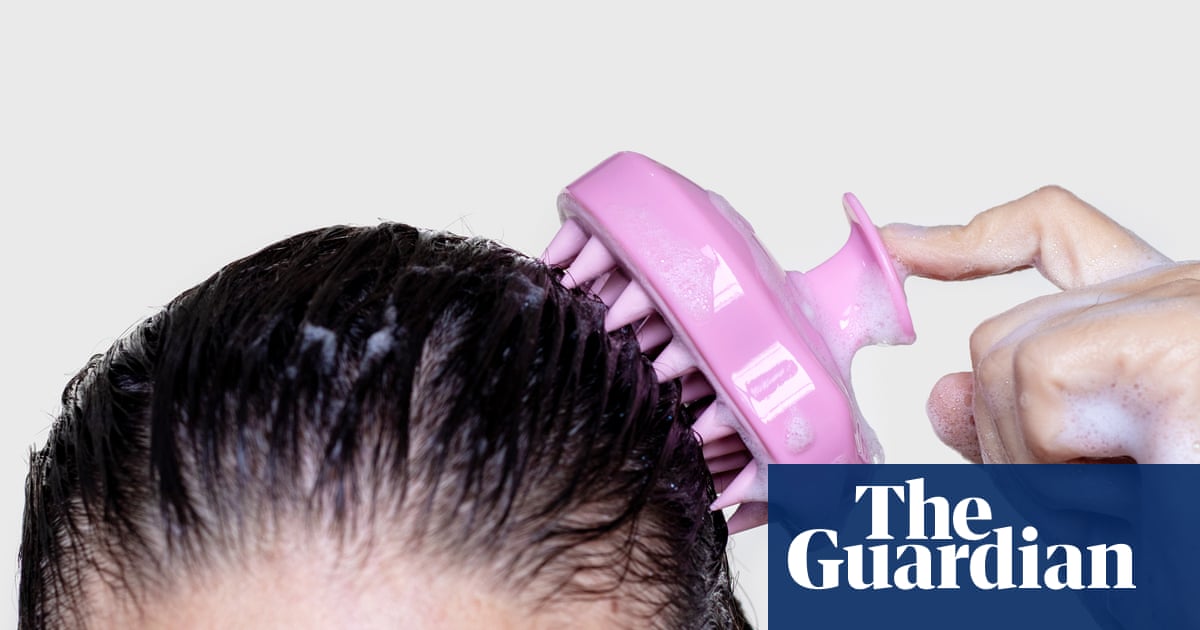
Scalp-care videos on TikTok have been viewed more than 2.6bn times. Google searches for “silicone scalp massager” jumped 250% in Australia alone over the past 12 months. New scalp-care brands including the Australian-founded Straand and Jupiter are securing millions in funding. And multistep hair regimens are dominating 2024 beauty trend predictions.
The Australian online beauty retailer Adore Beauty says they have seen a surge in scalp-health interest over the last 12 months. Site searches for scalp serums increased 2,000% year-on-year, and the number of scalp health products they stock grew 15% from 2022 to 2023.
“We’ve seen an explosion of products targeting scalp health in various ways, from sensitive scalps to dandruff control and those that enhance the scalp microbiome,” says Sadaf Razi, the retailer’s senior beauty editor.
“This trend reflects something we’re seeing more broadly in beauty around the premium-isation of products targeting what once might have been seen as somewhat taboo beauty concerns, like dandruff.”
But is scalp-care necessary, or just a fad set to lengthen routines and thin wallets without making a hair’s difference to our actual hair?
The Sydney-based dermatologist Dr Natasha Cook says the skin on the scalp and face “are very similar in needs”. Which means that maintaining scalp health has an impact on hair health, and growth. “An unwell scalp will lead to hair loss, not to mention the discomfort of flaking and itching,” she says.
Sign up for the fun stuff with our rundown of must-reads, pop culture and tips for the weekend, every Saturday morning
Jaye Edwards, the founder of Edwards and Co salons, says he has noticed an increased focus on scalp health from customers too, which he thinks is part of a broader trend towards “natural” beauty. People have started to see their scalps as “the foundation and key to growing strong, healthy hair”, he says.
The pharmaceutical scientist Hannah English, who regularly posts about beauty to her 68,000 Instagram followers, believes people have become more open to discussing conditions such as dandruff, which affects 50% of adults at some time in their life, as well as spending more money to fix it. “A really large proportion of people experience a flaky scalp and even though it can be embarrassing we’re less hesitant to talk about it,” she says.
But for those experiencing flaking, irritation, thinning or hair loss, English emphasises the need for professional medical advice from a GP or dermatologist. “Time is of the essence,” she says.
Cook agrees that itching and flaking is the scalp “telling you something is wrong”. The fix could be as easy as switching to a gentler shampoo and conditioner, but more persistent problems require professional assessment.
Scalp health starts with hair washing, which should be done once or twice a week. More than that will strip the natural oils and barrier, which can lead to inflammation.
Hair care routines should also be tailored to the scalp’s condition, and other grooming habits. Edwards suggests those who regularly use products such as hairspray or dry shampoo should use an exfoliating scrub to remove buildup and stabilise oil production.
Cook suggests using a leave-in conditioning treatment, eating a balanced diet rich in antioxidants and nutrients, and regular hair brushing, which helps with growth by improving blood circulation to the hair follicles.
English says that sun damage can cause scalp irritation, and suggests wearing a hat and using sunscreen.
Using a silicone massage brush during hair washing can make the experience more pleasurable, but English says evidence that these products actually improve hair growth “is anecdotal at this point”. She also says that while products such as serums, oils and scrubs might help with hair health, they “aren’t as evidence-based for hair growth as say, pharmacy medicines”.
While many scalp-care products cost as much as their skincare counterparts, these prices are dwarfed by the expense of scalp light therapy devices, which often retail for over $1,000.
English says there is some evidence that red light helps with pattern hair loss – androgenetic alopecia – but stresses it is critical to invest in professional advice first. “If something is imbalanced it will need to be corrected,” she says. “Otherwise it’s like pouring water into a bucket with a hole in it.
“If you’re experiencing hair loss ask your pharmacist, GP or dermatologist before you reach for supplements or $1,000 treatments.”
Cook says at-home LED devices may help with hair loss, but “most of the pioneering studies have been done on technologies that are a lot more complex, expensive and effective, and used by doctors in clinics”.
“These cost approximately $15,000 to $25,000 depending on the number of wavelengths and how sophisticated the technology is.”
She concludes that people should take any beauty trend with a grain of salt, especially “TikTok and Instagram fads from people who have little to no education”.
“Remember the beauty industry is a billion-dollar industry often founded on minimal research, as there is money to be made.”












